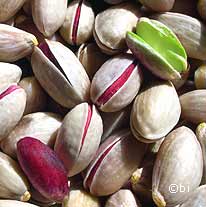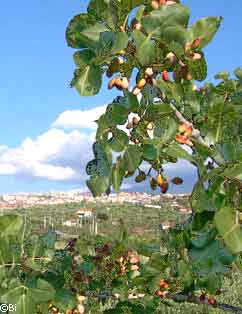Bronte, the Italian capital of the pistachio The green pistachio of Bronte dop  Sicily is the only Italian region where the pistachio ("pistacia vera") can be cultivated and produced. Bronte, with nearly three thousand hectares of land dedicated and specialized for this purpose, expresses principal area of cultivation (80% of the regional surface), with a production that has peculiar characteristics. Bronte is the Italian capital of the pistachio. Sicily is the only Italian region where the pistachio ("pistacia vera") can be cultivated and produced. Bronte, with nearly three thousand hectares of land dedicated and specialized for this purpose, expresses principal area of cultivation (80% of the regional surface), with a production that has peculiar characteristics. Bronte is the Italian capital of the pistachio.
Represents the principal economic resource of the territory, also because, unlike the product coming from America or Asia, whose kernel is nearly always yellowish, the bronte's pistachio is a fruit of high value, much appreciated in the European and Japanese markets, for its intense green coloration. In Bronte are picked up over 30 thousand quintals and is sold at about 5.00 to 7.00 euro per kilo with shell and at 12.00 to 15.00 without it. A wealth of about 20 millions Euro that represents 1% of the world production. Certainly no farmer nowadays can make a living out of cultivating only pistachio. This activity occupies only a part of the working engagement and supplies only a part of the income; practically it is a second activity, but essential for the family survival and maybe it is more the passion than the economic reason to push the farmers to plant evermore pistachio trees (that shall give fruits only after about ten years). The green pistachio of Bronte could certainly be the city's emblem: its longevity, its willpower to overcome any adversity, even to bear fruits although clinging on lava rocks, reflect somewhat many characteristics of the bronte's people. A people that is not afraid of hard work, that has always struggled to take home what is necessary; that over the pistachio has built wealth, culture and its traditions, but also the habit to respect the territory in which lives.  It is a precious fruit from ancient and noble origins, always a protagonist in the more refined kitchens, sought-after for its aromatic and pleasant taste. It is a precious fruit from ancient and noble origins, always a protagonist in the more refined kitchens, sought-after for its aromatic and pleasant taste.
In particular, today, is utilized in the sphere of sweets and salami factories (confectionery, salami), but also in chemistry and cosmetics (well known the active principles of its oil, to beautify the skin). The oil extracted from the fruit, particularly delicate, finds application in dermatology for its high emollient and softening quality. Was known and cultivated by the ancient Jews and it was then considered a precious fruit: Jacob says to his sons to try to soften the heart of the Pharaoh Assurbanipal offering to him these gifts: «… a little resin, some honey, some myrrh, some pistachio and some almonds» (Genesi XLIII, v.11). The pistachio (from the Greek Pistàkion) was already known to Assyrians and Greeks as a medicinal drug, a powerful aphrodisiac and as an antidote against bites of poisonous creatures. Avicenna, considered the Hippocras and the Aristotle of the Muslim East, in his "Canon of Medicine" prescribed it against liver diseases and as an aphrodisiac. During the high middle ages were the Arabs that, having taken away Sicily from the Byzantine, incremented the pistachio cultivation and this had a great expansion in the territory of Bronte. Of Arab origin are, in fact, the words frastuca and frastucara that respectively indicate the fruit (in Arab "fustuq") and the plant. In the sciare (stony ground) of Bronte, in fact, was realized an extraordinary union between the plant and the lava ground, that continuously fertilized by the volcano' ashes, favored the production of a fruit that, for taste and flavor, is far superior of the remaining world production. Here, in a steep and stony land, the brontese peasant has reclaimed and transformed the lava flows of Etna in an unusual Eden, realizing the miracle of a plant born from the rocks to produce small, tasty fruits of the highest quality, of a beautiful color: emerald green, sought after and used in confectionery and gastronomy for their elevated organoleptic proprieties.
|